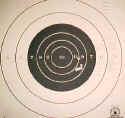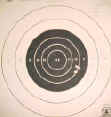Do
It Yourself:
2 Marlins Made Into Trappers
More bad influence from Miles Fortis & A K Church
28th February, 2004
Some
1960s vintage gun magazine carried an article by the then-active gunwriter Mason
Williams. He tested a Numrich Arms .44 Magnum barrel for '92 Winchesters. He
completed the gun, range tested it, and took it on a hunt for the now endangered
Florida Swamp Deer. Couldn't do that now.
The
barrel he tested was just comfortably past the US legal minimum of 16". He
commented favorably on the fast handling of the little carbine, but what hit
author Church was the ferocious STYLE the little bigbore carried. It
looked great-serious in a stripped down minimal way. As a 1970s teenager, it
burned its looks into my mind, and I wanted it.
In
the time since, I've handled the early '60s Marlin Marauder, a 16"+ version
of the straight grip 336T. A great handling gun, it sold poorly for a few years,
and is predictably now a sought after collectable. But again, the short barrel
looked great and I discovered HANDLED just as well.
Other
stuff fed the fever. A shortened '94 Winchester pictured in Tappan's SURVIVAL
GUNS. An article in AMERICAN RIFLEMAN on original, pre 1934, less
than 16" leverguns being reclassified as curios and relics in many
instances. The article had pictures of shortbarreled Winchester '94s, '92s, and
'73s. A 1934 AMERICAN RIFLEMAN article, a really great one by R. L.
Chatfield Taylor on working guns of the American Southwest, with a picture of a
12" '92 Winchester.
I
wanted to put together a faux Marauder based on a 336T, but those are now fairly
hard to get. Somehow the idea of building one on the super abundant pistol
gripped Marlin .30-30s currently choking pawnshops just didn't sound right-it
couldn't look right, it couldn't feel right.
Finally
a few years back, during the twilight of the late AMERICAN SURVIVAL GUIDE
magazine, author Gabe Suarez did a writeup on his views of the levergun as a
fighting rifle. Photographed in the body of the article was his pistol gripped,
generic 336 Marlin of recent vintage, but lopped back to
sixteen-point-something. It looked punk, disrespectful, and also entirely
purposeful.
To
make matters worse, esteemed gunwriter John Taffin EMailed Church photos of a
pistol gripped 336 he rebarreled with an original Marauder barrel and magazine
tube. As one would expect from Taffin, his execution was a class act-just as
John is.
So
I put it back in my head that if I ever got a job which, unlike my Wal~Mart job,
actually payed something, I was
going to get a cast off beater Marlin, and proceed with the amputation.
About
a year and a half ago, a candidate appeared.
The Cotter Westpoint Model 33

A
long time poster on the Sixgunner.com discussion board calling himself
"Slow Hand" offered up a private label version of the Marlin 336C.
Cotter Hardware, an ancestor of the giant TrueValue chain, sold guns under the
"Westpoint" trademark, and this gun, while not marked Marlin anywhere,
was serialled in the same block as other Marlins, and dates to 1967.
This
.30-30 is a mixed bag of parts. The pistol gripped black walnut buttstock is
standard for most 336s of the era, the forend is a capped rifle style, but the
magazine is a banded carbine type. So far it sounds very much like a walnut
version of the Marlin Glenfield line. Add to this a factory installed saddle
ring from the 336T series, and you have a pretty mixed up gun. 
Slow
Hand priced it quite reasonably at 2 bills, and it included a Lyman 66LA
aperture rear sight likely contemporary with the gun itself. It turned out to be
better than described. This guy was honest.
I
got it. It was actually a little above average in terms of fit and finish, a
funky uncommon variation, and in quite good, honest used shape. I thought long
and hard about cutting it. In the end, though, I knew I couldn't bring myself to
cut the Ballard rifled 336RC carbines I had show up at about the same time, and
this one just kept looking like it needed to be shorter.
So,
I hauled it to local gunsmithery Anderson Gun Repair, and told him to take it
back to 16 1/2 inches, recrown, rehang the front sight, and lop back the
magazine tube accordingly. I left it, and it was returned within the quoted
time.
I
was happy. We tweaked the front sight a little for deflection, and the job was
nice. Well crowned, the bands got tight on the barrel taper at  a
point which
dictated an actual barrel length of about 16 3/4. This is about 3 1/4 off the
original barrel, but the difference in handling was fantastic, not to mention
the ease of storing them in compact Japanese 4x4s.
a
point which
dictated an actual barrel length of about 16 3/4. This is about 3 1/4 off the
original barrel, but the difference in handling was fantastic, not to mention
the ease of storing them in compact Japanese 4x4s.
It
was eventually fitted with a buttstock shell carrier from local CAS leathersmith
Baldknobber Holsters.
It
is my favorite pseudo-Trapper, and I think looks very good.
.30 336-CS

With
its Marshield finished wood, goldtoned trigger, whiteline capped pistol grip,
and ramp front sight, this gun from 1979 represents a very common gun on the
used market-save for the lack of crossbolt safety, it's little different from
guns available new.
This
one has led a hard life. Over 15 years as a worker bee on an Ozarks farm, it's
apparently seen a fair bit of rain and humidity, and scars are abundant on wood
and steel.
A
co-worker needed money during a divorce, and it became mine for $140. Rough, but
it worked fine, was nearly new feeling in the action, and a few preliminary
rounds flung downrange indicated a gun which shot at least acceptably.
I
have 2 small 4WD trucks, and somehow this told me I needed 2 sawed-off leverguns.
Or at least I wanted them. So The Pride of 1979 went back to Anderson's.
 The
gun was different, and the details of execution were different. The front sight
on newer Marlins is forward of the magazine band, and this required a shortened
factory ramp. The magazine tube was run all the way to the muzzle, and on this
gun it was possible to set up the magazine to retain full capacity. It often
isn't, and it was difficult on this one. Overall barrel length is nigh on to
identical to 1967 gun, at more or less 16.75". For something different, a
benchrest crown was used this time-a handsome touch on a well worn beater.
The
gun was different, and the details of execution were different. The front sight
on newer Marlins is forward of the magazine band, and this required a shortened
factory ramp. The magazine tube was run all the way to the muzzle, and on this
gun it was possible to set up the magazine to retain full capacity. It often
isn't, and it was difficult on this one. Overall barrel length is nigh on to
identical to 1967 gun, at more or less 16.75". For something different, a
benchrest crown was used this time-a handsome touch on a well worn beater.
Again,
a buttstock ammo carrier was installed. A Williams Foolproof rear sight was installed on this one - I like the Lyman better, but I had a spare Williams. Both
work, the Lyman on the 1967 is more compact and attractive, but the Williams is
easier to get.
installed on this one - I like the Lyman better, but I had a spare Williams. Both
work, the Lyman on the 1967 is more compact and attractive, but the Williams is
easier to get.
SHOOTING
I
never shot the Cotter before I had it cut. Afterwords, it has shown tendencies
for me to group in to 2-2 1/2 inches at 100, when I do my part. What it might do
for a shooter with better skills and eyesight is open to conjecture. The Lyman
was a fortuitous touch-an aperture sight is really a neccessity on the shorter
guns to achieve adequate sight radius. We had a stiff cold wind the day we
tested this gun, and only 25 yards available. This is by no means the best
accuracy the carbine can yield.
I
did shoot the battered 1979 gun a little before it was lopped back. I will say
that accuracy might have improved after the shortening-whether this is from a
stiffer barrel, a better crown, or something metaphysical and mystic I cannot
say. 1979 has a better trigger, 1967 has a an odd creep at the start of the pull
which is offputting. It may be more accurate than 1967 despite its lack of
beauty. The Williams came off another gun, onto this one, and the rifle is close
to on as is. The trigger on this gun is not bad, and it feels just a bit heavier
than the 1967 gun.
On
a gusty, breezy day, Miles tooks over for a broken-ribbed A K, and shooting off
an MTM ammo box, got the following groups.
HANDLING
1967
feels thinner in the forearm, and a little lighter overall. 1979 is chunkier,
but blessed with a better trigger pull. Both rear sights run standard apertures,
and predictably the picture at that end is about identical. Let me note that
ghost rings absolutely don't work for me, and I use standard hunting apertures
in both. 1967 has a much brighter front bead, and is more visible up front.
Neither
gun is set up for slings. The saddlering on the Cotter gets in the way of a left
handed shooter's thumb.
CONCLUSION
We
chronographed current Winchester 170 grain ammo out of the 1979 gun, getting
consistent ballistics of upper 1900 foot second range. This is more velocity
than the rated ballistics of the original 1895 vintage 160 grain load, so I
personally have no issues with its adequacy for killing whitetail deer out to
100+ yards.
Accuracy
seems at least average for this sort of gun. In the case of the 1979 gun,
accuracy may have improved slightly.
Balance
is slightly less muzzle heavy than was the case in the 20 inch days. It is still
muzzle heavy, and with the chunky 336 action, a 16" Marlin is still not
going to be as fast or light as a 16" Winchester '94.
But
it does feel good-solid and still very fast. It settles quickly in offhand
shooting.
I
consider both projects a success.


